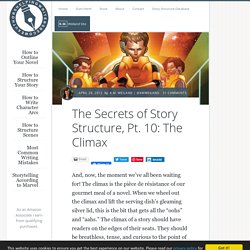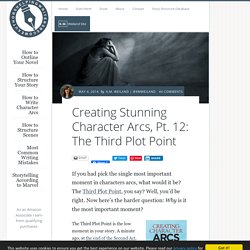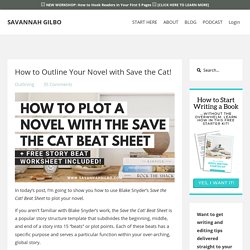

The Secrets of Story Structure, Pt. 10: The Climax. And, now, the moment we’ve all been waiting for!

The climax is the pièce de résistance of our gourmet meal of a novel. When we wheel out the climax and lift the serving dish’s gleaming silver lid, this is the bit that gets all the “oohs” and “aahs.” The climax of a story should have readers on the edges of their seats. They should be breathless, tense, and curious to the point of bursting. The Secrets of Story Structure, Pt. 9: The Third Act. The third act is the moment we’ve all been waiting for—readers, writers, and characters alike.

This final section of the story is the point. It’s what we’ve been building up to all this time. Creating Stunning Character Arcs, Pt. 12: The Third Plot Point. If you had pick the single most important moment in characters arcs, what would it be?

The Third Plot Point, you say? Well, you’d be right. The Link Between Your Story's First Plot Point and Third Plot Point. I often talk about cohesion and resonance as being two of the most important qualities of great stories.

Many factors are involved in achieving these effects, but one of the subtlest and yet most powerful is found within the structure of story itself. This is the hidden “circle” of story structure, in which all the important beats in the first half can be seen as foreshadowing for their “partner” beats in the second half. Over the last few weeks, we’ve been examining the idea that story structure can be viewed not just as an arc but as a circle. So far, we’ve talked about the link between the Hook and Resolution and the link between the Inciting Event and the Climactic Moment.
What Are Pinch Points? And How Can They Make Your Book Easier to Write? You may have heard of these little darlings called “Pinch Points.”

Of all the important structural moments in your story, they’re the most likely to be neglected. They get lost amidst all the excited chatter about their bigger, flashier brethren: the Plot Points. But Pinch Points–two of them, both occurring in the Second Act–are crucial to your story’s structure. I realized I’ve never written a proper post on Pinch Points, so today I figure it’s time to remedy that. Layering 10-20-30 Scenes in Your Novel. We’ve spent quite a few weeks taking a look at the ten key scenes a variety of writers have offered to share with readers of Live Write Thrive.

As many respected writing instructors teach, it’s crucial that novelists get the important scenes worked out and laid out in the right place to ensure a solid framework for a story. That won’t make up for a weak premise or boring characters. 20 Key Scenes for Writers of Romance Novels. Last week we began a discussion on romance novel structure.

While just about any story of any genre can work off the base of the ten key foundational scenes, from there, a whole lot of variety can take place. My aim in this series is to throw ideas and examples at you, so you can see how to work both within and outside of this framework. Your premise and plot are going to be the big factor when it comes to determining what kinds of scenes are needed to layer over those initial ten. It’s not just a matter of coming up with plot ideas and stuffing them into the framework, as if they were so much cotton batting going into a sofa. How to Layer Scenes in a Romance Novel. This week (and for over some additional weeks) I’m going to show you how you can layer those next ten scenes in a romance novel.

Maybe you don’t write romance, but don’t navigate away. There are some key elements to structuring romance novels that you may want to incorporate in your fantasy novel or thriller. How to Layer Scenes in a Romance Novel. How to Outline Your Novel with the Save the Cat! Beat Sheet. Step 4: What Happens in Each Beat?

So, now that you have the approximate location of the beats figured out, you can start brainstorming what each beat will look like in your story. As you read through the description of each story beat below, write down any ideas you have on the downloadable worksheet or in your notebook. Act 1 / The Beginning 1. Make Yourself Great Again - Complete Collection: An Introduction to Mindset ... - Dr. Robert C. Worstell - Google Books.
Anatomy of story. Here's a novel outline that contains the common elements of Harry Potter, The Hunger Games, and Twilight. Gordon Napier Online. The Hero’s Journey Joseph Campbell studied myths from cultures all around the world and found a number of recurring incidents featured in these stories despite the fact these cultures were separated by time and distance and were impossible for them to have come in contact with each other.

He concluded that these recurring incidents were part of human psyche. He outlined this in his book Hero with a thousand faces. To really understand this theory you need to read his book. These pages are presented as a guide to give a brief overview of the stages and to assist in creatively interpreting the stages for your own writing. How to Create a Book that Will Keep Readers Reading - Plot Worksheet.
Want to create a book readers can't put down? A book you'll itch to write? A protagonist you'll love? An antagonist who will give you shivers? And (simultaneously) the first draft of a synopsis you can send to literary agents? Like many writers struggling with the question of how to create a good book, I've spun my mental wheels researching and experimenting with different methods of plotting: outlining versus free writing versus turning points versus notecards versus snowflake method etc.
4. Write_Your_Novel.pdf. 1. Free_Novel_Outline.pdf. Plot Mapping. Good morning and welcome to Crafting Your Career. I used to think keeping track of my plot ideas was like trying on bathing suits. I would just have to keep going until I found something that worked. I’ve tried outlining, scene charts, character charts, goal-motivation-conflict charts, you name it. The Mysterious Arc of Romance with Kate Carlisle. NY Times Best Selling author Kate Carlisle pens the wonderful Bibliophile Mysteries series and also writes for Harlequin Desire. Today, she joins us to discuss the difference between the romantic arc in mysteries and romances.
Welcome Kate!
Live. Write. Thrive.